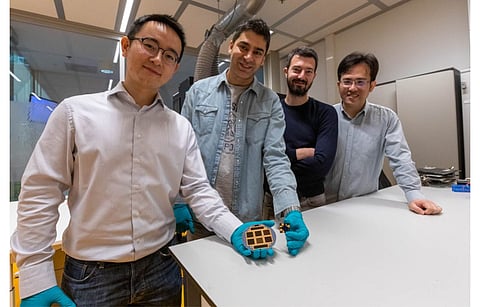

Solliance consortium has reported crossing the power conversion efficiency barrier of 30% for tandem solar cells with 30.1% efficiency for 4-terminal (4T) semi transparent perovskite silicon tandem cell at the 8th World Conference on Photovoltaic Energy Conversion (WCPEC-8).
The Solliance team comprises the Netherlands Organization for Applied Scientific Research (TNO), Delft University of Technology (TU-Delft), Eindhoven University of Technology (TU Eindhoven) and Belgian research institute imec.
For the research, the team used a silicon device 20×20 mm² wide with a heterojunction (HJT) solar cell having an optimized surface passivation, transparent conductive oxides and Cu-plated front contacts for state-of-the-art carrier extraction.
"This type of solar cell features a highly transparent back contact that allows over 93% of the near infrared light to reach the bottom device. This performance was achieved by optimizing all layers of the semi-transparent perovskite solar cells using advanced optical and electrical simulations as a guide for the experimental work in the lab," said TNO's Dr Mehrdad Najafi.
The silicon device at the bottom with 10.4% efficiency points to the total solar energy conversion with 19.7% being contributed by perovskite on the top, explained the team. Combined 30.1% is the efficiency of this non-area matched 4T tandem devices operating independently.
Announcing the feat at WCPEC-8, the researchers said in 4T tandem devices both top and bottom cells operate independently of each other making it possible to apply different bottom cells in this kind of device. This means be it PERC, HJT, TOPCon or thin film technologies as CIGS can be implemented in a 4T tandem device without majorly modifications to the cells.
Such an architecture also makes it 'straight forward' to implement bifacial tandems to further boost the energy yield.
"Now we know the ingredients and are able to control the layers that are needed to reach over 30% efficiency. Once combined with the scalability expertise and knowledge gathered in the past years to bring material and processes to large area, we can focus with our industrial partners to bring this technology with efficiencies beyond 30% into mass production" according to Program Manager Tandem PV technology and application at TNO, Prof. Gianluca Coletti.
In July 2022, Switzerland's EPFL and CSEM breached the 30% efficiency barrier for perovskite-on-silicon tandem cells on 1cm² with 30.93% for perovskite laters on planarized silicon surface (see Record Tandem Cell Efficiency Made In Switzerland).
